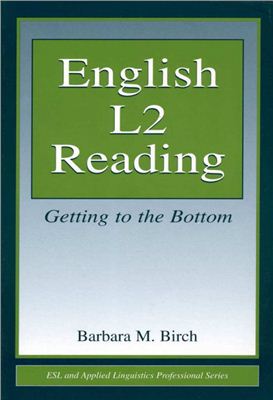ISBN 0-8058-3899-6, Published in 2002 by Lawrence Erlbaum
Associates, 200 pages.
English language—Study and teaching—Foreign speakers.
Second language acquisition.
Reading comprehension.
This book is a comprehensive, myth-debunking examination of how L1 features (orthographic system, phonology, morphology) can influence English L2 reading at the "bottom" of the reading process. It provides a thorough but very accessible linguistic/psycholinguistic examination of the lowest levels of the reading process. It is both theoretical and practical.
Although the methodologies and approaches taken in most ESL/EFL texts about reading are top-down (cognition driven), and pay scant attention to the bottom of the reading process, those detailed in this book are language driven. The goal is to balance or supplement (not replace) top-down approaches and methodologies with effective low-level options for teaching English reading. Core linguistic and psycholinguistic concepts are presented within the context of their application to teaching.
Pre-reading discussion and study questions are provided to stimulate interest and enhance comprehension. End-of-chapter exercises help readers apply the concepts.
Presents complete, balanced approach to L2 reading theory & methodology, taking the position that what works best is supplementing whole language with bottoms-up focus. Textbook for ESL/EFL reading theory and methods courses, & relevant for practitioners
English language—Study and teaching—Foreign speakers.
Second language acquisition.
Reading comprehension.
This book is a comprehensive, myth-debunking examination of how L1 features (orthographic system, phonology, morphology) can influence English L2 reading at the "bottom" of the reading process. It provides a thorough but very accessible linguistic/psycholinguistic examination of the lowest levels of the reading process. It is both theoretical and practical.
Although the methodologies and approaches taken in most ESL/EFL texts about reading are top-down (cognition driven), and pay scant attention to the bottom of the reading process, those detailed in this book are language driven. The goal is to balance or supplement (not replace) top-down approaches and methodologies with effective low-level options for teaching English reading. Core linguistic and psycholinguistic concepts are presented within the context of their application to teaching.
Pre-reading discussion and study questions are provided to stimulate interest and enhance comprehension. End-of-chapter exercises help readers apply the concepts.
Presents complete, balanced approach to L2 reading theory & methodology, taking the position that what works best is supplementing whole language with bottoms-up focus. Textbook for ESL/EFL reading theory and methods courses, & relevant for practitioners

